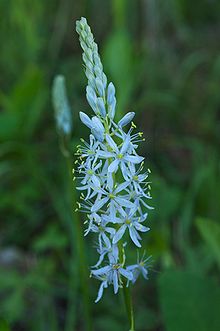Camassia scilloides
| Camassia scilloides | |
|---|---|
 |
|
| Scientific classification | |
| Kingdom: | Plantae |
| Clade: | Angiosperms |
| Clade: | Monocots |
| Order: | Asparagales |
| Family: | Asparagaceae |
| Subfamily: | Agavoideae |
| Genus: | Camassia |
| Species: | C. scilloides |
| Binomial name | |
|
Camassia scilloides (Raf.) Cory. |
|
| Synonyms | |
|
Camassia esculenta |
|
Camassia esculenta
(Ker Gawl.) B.L.Rob.(nom. illeg.)
Camassia scilloides is a perennial herb known commonly as Atlantic camas, wild hyacinth, and eastern camas. It is native to the eastern half of North America, including Ontario and the eastern United States.
It produces inflorescences up to half a meter tall from a bulb 1 to 3 centimeters wide. It has a few leaves each up to 60 centimeters long. The flowers have light blue or whitish tepals and yellow anthers. The green or brown capsule is up to a centimeter long.
Native American groups used the bulbs for food, eating them raw, baked, roasted, boiled, or dried.
The superseded name Camassia esculenta (Ker Gawl.) B.L.Rob., (nom. illeg.) should not be confused with Camassia esculenta (Nutt.) Lindl., a superseded name for Camassia quamash supsp. quamash.
...
Wikipedia

